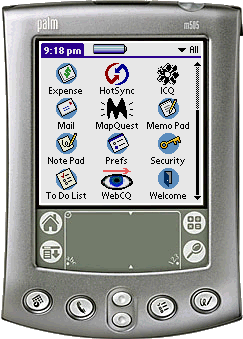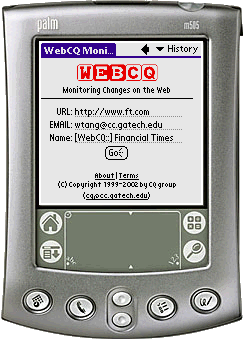Connecting An Information Change Monitoring Service with PDAs
Sponsor Ling Liu / Wei Tang
lingliu@cc.gatech.edu, wtang@cc
223 CCB /225b CCB
Area Systems and Databases
Problem
The rapid growth of the Web has changed the way in which information is
delivered and disseminated. The mode of data transfer is shifting from a
``pull-only'' model to a ``push-pull'' model. Instead of having users
track when to visit Web pages of interest and identify what and how the
page of interest has been changed, the push delivery enables changes to
be delivered while they are still fresh.
WebCQ is an automated change detection and notification service for Web
pages, developed at Georgia Tech. It can monitor and track various types
of changes to static and dynamic web pages, provide personalized delivery
of information change notifications, and personalized summarization and
prioritization of web pages being monitored. You may play with WebCQ at
www.cc.gatech.edu/projects/disl/WebCQ/.
One of the useful additions to the WebCQ is to build a Personal Digital
Assistant (PDA) agent for WebCQ, allowing users to install web page
sentinels and receive change notification from a hand-held computer.
Your objective in this project is to design and implement a PDA agent,
which includes a WebCQ user interface for PDA and a message exchange
service between WebCQ and the PDA agent. The goal of this project is to
build an active channel between WebCQ and PDAs, which enables information
changes to be delivered to the PDA users while they are still fresh.
Practical applications include monitoring weathers or airplane ticket
price for travelers (see an example:
Flight tracking),
monitoring product information for e-consumers, or
tracking how specific stocks are doing and notifying the PDA users when
the change to their stocks reaches certain thresholds. You are
encouraged to put your own insight into the PDA-WebCQ design and
implementation. For instance, there are at least two ways to build the
PDA-WebCQ agent:
1. Java GUI client without browser on PDA (Palm Pilot
preferred);
2. Converting WebCQ site to be WML-friendly (Wireless Markup
Language) so that access to WebCQ can be through a WML-enabled browser on
PDA. Currently, a prototype front-end on Palm devices is implemented in WebCQ
using Web Clipping technology. Two example screenshots
are displayed below:
Discuss with Dr. Ling Liu and me if you have any questions.
Background
You are expected to have a solid grasp of Java/Servlet programming. Java
will be the programming language. Sockets programming is not
required but desirable. Familiarity with the development on PalmOS or
WindowsCE platforms is a plus but not required. Understanding of basic XML/WML
technology will be useful in the project. You are expected to be a fast
learner because there are a lot to learn in this project and you need to
be able to apply the new technology relatively fast. But it is worth the
time since you will learn cutting-edge technologies.
Links
Here are some links to help you get started (be sure to read the
licensing documents before you download the software packages):
Deliverables
A report, describing your application, the insights in your project, and
future improvements/extensions.
The source code for your PDA-WebCQ agent, including the UI software and the
PDA-WebCQ communicator, and your application. Target application needs to
be tested on the PalmOS Emulator.
Evaluation
You will be graded on the novelty and quality of your PDA agent and your
report.



